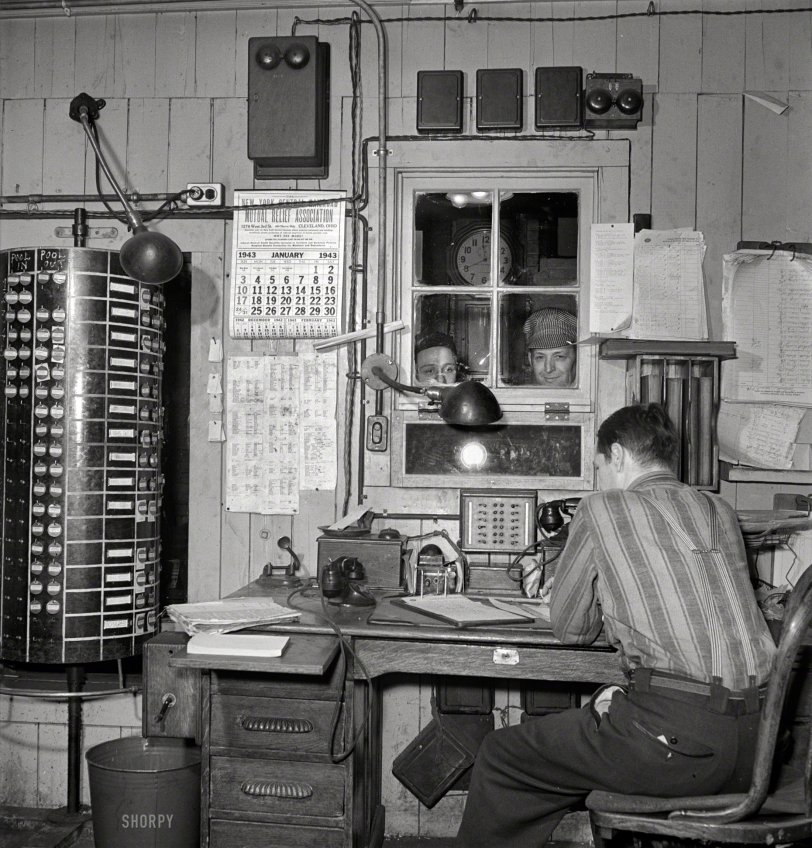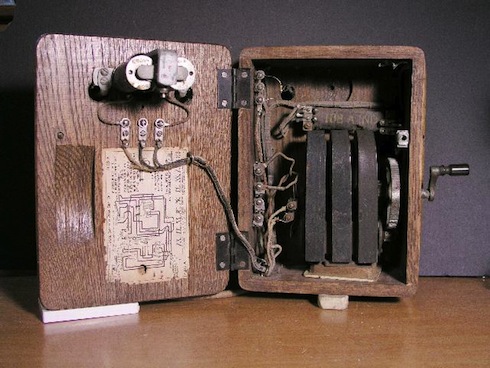


Framed or unframed, desk size to sofa size, printed by us in Arizona and Alabama since 2007. Explore now.
Shorpy is funded by you. Patreon contributors get an ad-free experience.
Learn more.

- Baldwin 62303
- Baldwin VO-1000
- Cold
- No expense spared
- Tough Guys
- Lost in Toyland
- And without gloves
- If I were a blindfolded time traveler
- Smoke Consumer Also Cooks
- Oh that stove!
- Possibly still there?
- What?!?
- $100 Reward
- Freeze Frame
- Texas Flyer wanted
- Just a Year Too Soon
- WWII -- Replacing men with women at the railroad crossing.
- Yes, Icing
- You kids drive me nuts!
- NOT An Easy Job
- I wonder
- Just add window boxes
- Icing Platform?
- Indiana Harbor Belt abides
- Freezing haze
- Corrections (for those who care)
- C&NW at Nelson
- Fallen Flags
- A dangerous job made worse
- Water Stop
Print Emporium
The Pool Board: 1943

January 1943. "Freight operations on the Indiana Harbor Belt railroad between Chicago and Hammond, Indiana. The engine crew, engineer and fireman report at the roundhouse office to be assigned their engine and given orders for the day. The cylinder at the left is the pool board; it lists the names of the men and the order and shift in which they will work." Photo by Jack Delano. View full size.
Pool Board quick [?]
On B&O at least, the engineers' pool and conductors' pools were separate. Since one pool had a few more crews than the other, this was necessary.
Engineers pools included a fireman, and later, a trainee, while the conductors turns showed the head brakeman,flagman, and in 1943, maybe a swingman. If a position was vacant, no peg was there. Bulletins were issued weekly advertising vacancies on regular jobs/pool crew and new jobs.
If you look to the right side of that board, those tags seem to show regular train or probably yard assignments; these would show the engineer, fireman, conductor [yard foreman on B&O] and the switchmen.
In practice, if a man was off, i.e. sick or vacation, etc., his tag was removed from his regular assignment and shown in what ever status. Somewhere on that board are extra boards for engineers, road conductors, brakemen, etc. As these extra men are called, their pegs are placed on the appropriate job with its regular men; when their trip is over, they are marked back up on the extra list at the bottom.
Note there is a window behind the board; this way a man can look at the board to see where he "stands" as he marks up, and see where everyone else is too. (The crews were kept on the other side of the window. Time slips, orders, etc. were handed through the "dutch window" above the caller's head.An experienced man could look this board over and tell you what job he's working tomorrow, and what job you're working too.[Sorry, Dave. This is about as quick as I could make this...]
The tags.
As this photo was taken in a roundhouse/engine terminal office, they'd be paired for an locomotive engineer and fireman. IHB in those days was a terminal/switching road, so the assignments would most likely be for switching jobs or transfer runs.
Merch, baby!
The Shorpy Store (TM) doesn't seem to stock that attractive Shorpy(R) brand wastebasket... that's a missed revenue opportunity!
Pool board
How does the pool board work? Is it meant to be rotated when there's a shift change, so that the current shift is visible and the off-duty shift is on the "dark side"?
What information is being represented? Why are the tags in pairs - is it driver/conductor teams? Does the column of tags with labels represent assignments to trains? Is the Pool In/Pool Out like the bench?
Carbide lamp
The bright image in the lower window appears to be a carbide lamp probably an oxweld they were extremely common for that time.
If you see one
you’ve seen 'em all. There must have been a written code somewhere that all railroads subscribed to regarding yard office ambience. They were all the same until recently. Wires and bells and speakers everywhere. Wooden floors, bare bulbs, block phones, doors that closed somewhat tightly, and restroom facilities that challenged the dignity of anyone other than a rail. (The old Humboldt Yard Office of the Milwaukee Road had a urinal that consisted of a large sheet of tin fixed to the wall that one [there were no women in those days] would pee against, and the urine would run down the tin into a horizontal length of rain gutter.) Although I can’t be certain, I’m going to guess the featured picture was taken at the IHB Blue Island yard. The two guys in the window are in their locker room, apparently waiting for a clearance and orders, or getting ready to tie up.
One long wait
The crank is almost certainly a ringer for the phone system.The wooden box is in character for the elderly, in-house phone set ups. In the early 70's, B&O trackside phones in places had a crank on a wooden box with a mouthpiece from a Laurel and Hardy flick. Penciled inside the cabinet were the different rings, for example "HB Tower:2 short; A Yard:1 long,3 short; HX Tower:1 long, to which a wiseguy added, "...and one long wait!"
To use the phone, first you'd pick it up and make sure it isn't in use, then ring the call for your party,the other end would answer with a short ring and then you talk by pressing a button. [this was to prevent background chatter; it was one big party line...] All of this was made antique collectibles by the radio, even to the removal of the phone lines themselves.
With the callboard nearby, someone in this office is a crewcaller, so the in-house phone line is for talking to the dispatcher, the trainmaster, the engine facility, etc. There also is a phone line to the outside, and if a crewman was within a certain distance from this office, callboys would go out and call at their doors. My name was on a similar board back in the "analog era". I wish I'd saved my peg.
State-of-the-Art Communications
That box with the crank is a magneto generator that produces ringing current of about 108 v.a.c.
It's matched up with the three oak ringers (one on the desk, two on the wall above the window), and the oak 3-hole jack box behind the archboard on the desk. These also work with the three selector boxes between the ringers on the wall.
Apparently he has 3 phone circuits. He chooses the one he wants to use with the jack box. To make an outgoing call, he cranks the magneto. Incoming calls are announced by the ringers, and the selectors control when the ringers announce an incoming call for this office.
Information about railroad telephone equipment of this era, including links to archived user's manuals, can be found here.
A little cranky?
@Carey - that is a telephone ringer. Inside the box is a magneto which generates a voltage so the operator knows there is an outgoing call. I used to have one just like this, which had bells on it like the one on the desk laying horizontally. They put out a good kick if you wanted to play a joke on someone.

Wooden box with crank
Anyone know what the wooden box with a crank handle is on the side of the desk over the trashcan? Being over the trash suggests some sort of shredder, but it's hard to imagine what they would have that needs shredding.
























On Shorpy:
Today’s Top 5